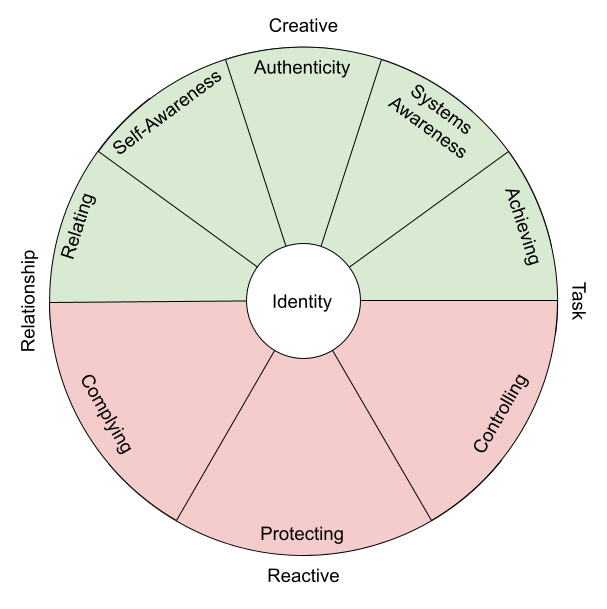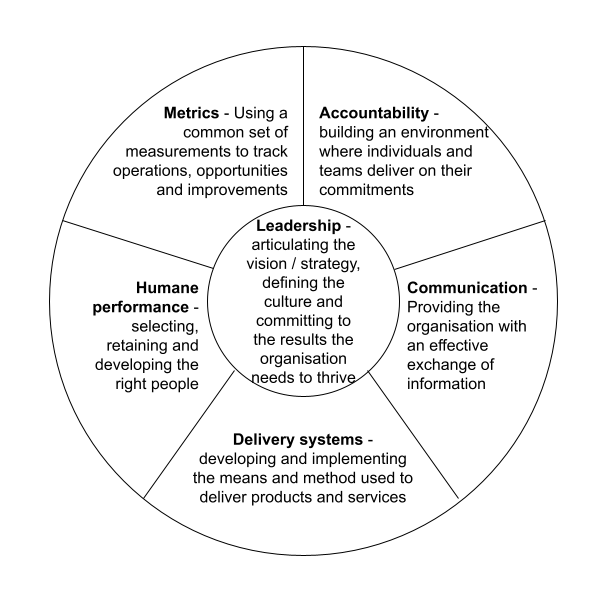 Mastering Leadership: An Integrated Framework for Breakthrough Performance and Extraordinary Business Results by
by Bob Anderson and William A. Adams (Goodreads Author)
Mastering Leadership: An Integrated Framework for Breakthrough Performance and Extraordinary Business Results by
by Bob Anderson and William A. Adams (Goodreads Author)
My rating: 4 of 5 stars
The book produces evidence that leadership effectiveness has a direct impact on bussiness results in the VUCA bussiness environment (volatility, uncertainty, complexity, ambiguity and disruption). Effective leadership is made up of the direction and meaning, engagement and accountability as well as focus and execution in a circle of improvement. To be an effective leader you have to master the outer game and inner game.
- Outer Game
- Leadership process
- Allocation and utilisation of resources (people, time and money)
- Business rhythm and management process of strategy, direction, execution, process, decision and decision making.
- Leadership competencies
- Outside game of leadership
- Leadership competency research
- Leadership process
- Inner Game
- Leadership consciousness
- Inside game of leadership
- Our meaning-making system
- Out decision making system
- Our values, beliefs and assumptions
- Our level of self-awareness and emotional intelligence
- Mental models to understand reality, think, act and create
- Evolving consciousness
- Inside game of leadership
- Leadership consciousness
The Universal Model of Leadership
At the root is our identity, on the left relationships, right tasks, below being reactive and above being creative.
Reactive
The Complying dimension measures the extent to which self-worth and security are felt by complying with the expectations of others rather than acting on what s/he intends and wants.
- Conservative – the extent to which thinking and acting is conservative, follows procedure, and lives within the prescribed rules of the organization with which s/he is associated.
- Pleasing – the need to seek others’ support and approval in order to feel secure and worthwhile as a person. People with strong needs for approval tend to base their degree of self-worth on their ability to gain others’ favour and confirmation
- Belonging – the need to conform, follow the rules, and meet the expectations of those in authority. It measures the extend to which s/he goes along to get along, thereby compressing the full extend of his/her creative power in culturally acceptable boxes.
- Passive – the degree to which power is given away to others and to circumstances outside of his/her control. This shows the measure of believing that s/he is not the creator of his/her life experience, that his/her efforts do not make much difference, and that s/he lacks the power to create the future s/he wants.
The Protecting dimension measures the belief that the leader can protect him/herself and establish a sense of worth through withdrawal and remaining distant, hidden, aloof, cynical, superior and/or rational.
- Arrogance – the tendency to project a large ego – behaviour that is experienced as superior, egotistic and self-cantered.
- Critical – to take a critical, questioning and somewhat cynical attitude
- Distance – a sense of personal worth and security through withdrawal, being superior and remaining aloof, emotionally distant and above it all.
The Controlling dimension measure the sense of self worth through task accomplishment and personal achievement.
- Perfect – the need to attain flawless results and perform to extremely high standards in order to feel secure and worthwhile as a person. Worth and security are equated with being perfect, performing constantly at heroic levels and succeeding beyond all expectations.
- Driven – are the individuals worth and security tied to accomplishing a great deal through hard work. It measures the need to perform at a very high level in order to feel worthwhile as a person. A good work ethic is a strength of this style, provided that there is balance helping others achieve with his/her own achievement.
- Ambition – the level to which there is a need to get ahead, move up in the organisation and be better than others. This is a powerful motivator, and can be positive (furthering progress) or negative (becoming overly self centred and competitive).
- Autocratic – the tendency to be forceful, aggressive and controlling. It measures the extend to which s/he equated self-worth with security to being powerful, in control, strong, dominant, invulnerable, or on top. Worth is measured through comparison; that is having more income, achieving a higher position, being seen as a most/more valuable contributor, gaining credit, or being promoted.
Creative
The Relating dimension measures the capability to relate to others in a way that brings out the best in people, groups, and organizations.
- Caring Connection – the interest in and ability to form warm, caring relationships with people.
- Fosters Team Play – the ability to foster high performance teamwork among team members who report to him/her, across the organization and within teams in which s/he participates.
- Collaborator – the extent to which the leader engages others in a manner that allows the parties involved to discover common ground.
- Mentoring & Developing – the ability to develop others through mentoring and maintaining growth-enhancing relationships
- Interpersonal Intelligence – the effectiveness of listening, engages in conflict and controversy, deals with the feelings of others, and manages his/her own feelings.
The Self-Awareness dimension measures the orientation to ongoing professional and personal development, as well as the degree to which inner self-awareness is expressed through high integrity leadership.
- Selfless Leader – the pursuit of service over self-interest, where the need for credit and personal ambition is far less important than creating results that serve a common good.
- Balance – to keep a healthy balance between business and family, activity and reflection, work and leisure, the tendency to be self-renewing and handle the stress of life without losing the self.
- Composure – the ability, in the midst of conflict and high-tension situations, to remain composed and centred and to maintain a calm, focused perspective.
- Personal Learner – demonstration of a strong and active interest in learning and personal and professional growth. To actively and reflectively pursues growing in self-awareness, wisdom, knowledge, and insight.
The Authenticity dimension measures the capability to relate to others in an authentic, courageous, and high integrity manner.
- Integrity – how well the leader adheres to the set of values and principles that s/he espouses; that is, how well s/he can be trusted to “walk the talk.”
- Courageous Authenticity – willingness to take tough stands, bring up the “undiscussables” (risky issues the group avoids discussing), and openly deal with difficult relationship problems.
The Systems Awareness dimension measures the awareness of the whole system improvement, productivity, and community welfare.
- Community Concern – the service orientation. The extent to which s/he links his/her legacy to service of community and global welfare.
- Sustainable Productivity – the ability to achieve results in a way that maintains or enhances the overall long-term effectiveness of the organization. How well human/technical resources are balanced to sustain long-term high performance.
- Systems Thinker – the degree to think and act from a whole system perspective as well as the extent to which decisions are made in light of the long-term health of the whole system.
The Achieving dimension measures the extent to which the leader offers visionary, authentic, and high achievement leadership.
- Strategic Focus – the extent to think and plan rigorously and strategically to ensure that the organization will thrive in the near and long term.
- Purposeful & Visionary – clearly communicates and models commitment to personal purpose and vision.
- Achieves Results – the goal-directed, track record of goal achievement and high performance.
- Decisiveness – the ability to make decisions on time and the comfort moving forward in uncertainty.
The six systems of organisation effectiveness
Leadership tension between safety (moving up, approval) in a reactive mind set and purpose (vision and contribution) in the creative mindset.
The reactive system sees problems as threats, which produce fear and a reaction. In this environment there is always an oscillation in results over time – when there is a threat it is extinguished with a result until a new threat comes along. The fear is based on internal assumptions and beliefs.
In the creative system purpose and vision drive passion which results in action. This cycle does not result in the oscillation of the reactive system and continues to improve over time.


